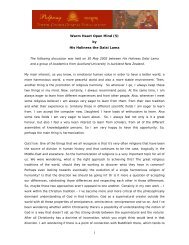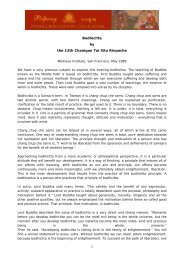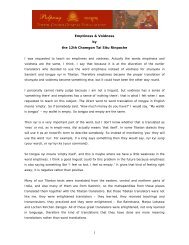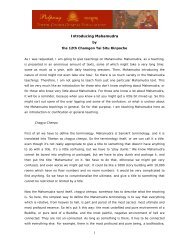1 The Essential Teachings of the Buddhadharma
1 The Essential Teachings of the Buddhadharma
1 The Essential Teachings of the Buddhadharma
- No tags were found...
You also want an ePaper? Increase the reach of your titles
YUMPU automatically turns print PDFs into web optimized ePapers that Google loves.
Meditation in <strong>the</strong> MahayanaIn <strong>the</strong> previous lecture I spoke about meditation practice from <strong>the</strong> Hinayana point <strong>of</strong> view. NowI wish to speak about meditation practice from <strong>the</strong> Mahayana point <strong>of</strong> view.When we follow <strong>the</strong> journey <strong>of</strong> <strong>the</strong> <strong>Buddhadharma</strong> along <strong>the</strong> path it is important to keep inmind that we do not become side-tracked or fall into <strong>the</strong> extremes <strong>of</strong> samsara or intocontentedness, some experience <strong>of</strong> personal peace. Instead <strong>the</strong> practice should be free <strong>of</strong>both. This is particularly important in Mahayana.According to <strong>the</strong> Hinayana, in Shamatha meditation one cultivates a gentle mind. It is bytaming <strong>the</strong> mind that gentleness is possible. But, one must not completely fall into <strong>the</strong> state <strong>of</strong>a stable and tranquil mind. Even within Hinayana, <strong>the</strong>re is <strong>the</strong> importance <strong>of</strong> practicingShamatha and Vipashyana. In Mahayana, <strong>the</strong> skillful means <strong>of</strong> bodhichitta is <strong>the</strong> practice thatprevents us from falling into any extremes.When speaking about cultivating bodhichitta, relatively it means developing <strong>the</strong> mind <strong>of</strong> lovingkindness and compassion, <strong>the</strong> true intention to benefit o<strong>the</strong>rs. Bodhichitta is <strong>the</strong> means todevelop genuine and altruistic openness, <strong>the</strong> inseparability <strong>of</strong> friendliness, loving kindness andcompassion. Ultimately it means <strong>the</strong> inseparability <strong>of</strong> <strong>the</strong> wisdom <strong>of</strong> emptiness and <strong>the</strong> skillfulmeans <strong>of</strong> compassion. Ultimately one must give rise to ultimate bodhichitta. <strong>The</strong> means toexperience ultimate bodhichitta is through relative bodhichitta, which has two aspects, <strong>the</strong>aspiration and <strong>the</strong> application. When we speak about ultimate bodhichitta, we refer to <strong>the</strong>description given in <strong>the</strong> sutras. In <strong>the</strong> tantras it is described as co-emergent wisdom, <strong>the</strong>re aredifferent names for <strong>the</strong> same meaning. <strong>The</strong> awakening to ultimate bodhichitta takes placethrough aspiration bodhichitta and application bodhichitta. <strong>The</strong> analogies for both are “wishingto go” for aspiration and “<strong>the</strong> process <strong>of</strong> going” for application. In this way one generates <strong>the</strong>two aspects <strong>of</strong> bodhichitta. One particular practice done in <strong>the</strong> tradition to cultivate aspirationbodhichitta is contemplating <strong>the</strong> four immeasurables: immeasurable loving kindness,compassion, joy and equanimity. <strong>The</strong> aspiration is <strong>the</strong> all encompassing intention to benefit allbeings without exception. <strong>The</strong> application is following <strong>the</strong> bodhisattva’s way <strong>of</strong> life inaccordance with <strong>the</strong> intention. As one follows <strong>the</strong> bodhisattva’s conduct, in o<strong>the</strong>r words, <strong>the</strong>way <strong>of</strong> <strong>the</strong> victorious sons and daughters, one engages in <strong>the</strong> six perfections <strong>of</strong> generosity,moral discipline, patience, perseverance, meditation, and wisdom.Following <strong>the</strong> path <strong>of</strong> <strong>the</strong> bodhisattvas and practicing <strong>the</strong> six perfections deals with engaging in<strong>the</strong> actions <strong>of</strong> a bodhisattva, called “Parol-du-Chin-pa” in Tibetan. “Parol-du” is “across” and“Chin-pa” is “gone,” so it means “gone beyond.” <strong>The</strong>refore <strong>the</strong> six perfections do not point to<strong>the</strong> usual qualities we speak about. Although a particular individual may practice greatgenerosity by doing an immeasurable amount <strong>of</strong> good this has nothing to do with “perfection.”13
















